SCIENCE IN PICTURES
A wing and an error
By Scott LaFee
UNION-TRIBUNE STAFF WRITER
May 22, 2008
On the afternoon of April 26, 1986, Cornelia
Hesse-Honegger was painting mutated laboratory flies, part of her job as
a scientific illustrator at the Natural History Museum in Zurich, when
the news drifted in:
The Chernobyl nuclear power plant, near the
Ukrainian town of Pripyat, had experienced a catastrophic meltdown. Plumes
of radioactive material were spewing out, heading west. Within days, they
would sweepover western Russia and much of Europe, even reaching parts
of NorthAmerica.
Hesse-Honegger looked at the flies she was
painting, their distorted bodies the tangible consequence of intentional
X-rayexposure. Now "radioactivity was spread all over Europe, including
Switzerland," Hesse-Honegger said. Everybody and everything downwind
ofChernobyl would become, like the flies, part of a giant lab experiment.
In the 22 years since Chernobyl, innumerable
studies have been conducted to assess the health and environmental consequences
of the radiation release. Answers have been mixed and remain hotly debated.
Atleast one aspect of the aftermath, though, has garnered relatively little
interest or study: What happened to bugs?
At the time, Hesse-Honegger suspected quite
a lot, and none ofit good. But she could find little relevant research.
When she asked a distinguished colleague what he thought, the geneticist
declared radiation levels in Europe too low to have much of an effect,
if any,on bugs.
Insects were too small and simple, he said,
to be much bothered by radiation.
Hesse-Honegger was not persuaded. The 64-year-old
artist, whohas been painting biological specimens for more than 30 years,
had cometo regard the irradiated mutant insects she drew as "physically
rendered prototypes of our destructive behavior." She thought nuclearradiation
boded ill for all creatures, great or small, two legs or six.She set out
to find some scientific proof.
Over the next two decades, Hesse-Honegger
collected more than 16.000 insect specimens, primarily true bugs, an order
of insects(Heteroptera) consisting of roughly 40.000 known species, from
cicadasand leafhoppers to aphids and shield bugs.
Hesse-Honegger gathered these insects at sites
throughoutEurope and from every continent except Australia, visiting fields
and forests, homes and gardens near working nuclear plants and waste sites,
including Three Mile Island in Pennsylvania and the decommissioned nuclear
production facility near Hanford, Wash.
Then, she drew what she found, producing more
than 300 watercolor illustrations depicting various types of malformations,
some pictured here. The insects were drawn true to scale, each detail precisely
measured with a microscope. To reproduce the insects' colorsfully and accurately,
Hesse-Honegger painted them without any shadowing effects. The results
are meticulously rendered, vibrant and almost photographic in detail.
Contrary to her colleague's declared wisdom,
Hesse-Honegger said her research indicates true bugs are significantly
affected by even low doses of artificial radiation.
In areas around nuclear power plants and processing facilities in Switzerland,
France and Germany, for example, more than 30% of the bugs collected and
examined exhibited physical damage: missing antenna sections, malformed
wings, asymmetric body segments, ulcers, black spots or altered pigmentation.
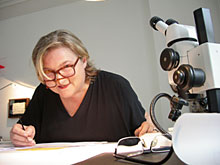
Cornelia Hesse-Honegger, a Swiss scientific illustrator, collected
more than 16,000 insect specimens near nuclear plants and waste sites around
the world. Her watercolor paintings record a variety of malformations.
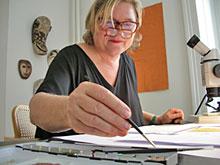
Courtesy of Cornelia Hesse-Honegger
Cornelia Hesse-Honegger said her paintings of misshapen insects are
"a serious alarm call," but more research is needed on radiation's
effects. |
"This is far above the values expected
for natural populations,about 1%, or those determined for true bugs living
in biotopes considered as relatively intact, 1 (percent) to 3%," she
writes in a paper to be published in the journal Chemistry & Biodiversity.
Her research uncovered another surprising
finding: It was not proximity to a nuclear facility that determined physical
damage to the bugs, but rather wind direction and local topography. Areas
downwind of a nuclear facility, even those at a great distance, had much
higher rates of insect malformations than closer but protected areas.
Hesse-Honegger found that radioactive elements
such as tritium,carbon-14 and iodine-131 were constantly being emitted
by functioning nuclear power plants, transported as aerosols on the wind
and absorbedby host plants consumed by insects.
"Such a low but long-lasting dose of radiation
can be far more damaging than a short-term high dose," Hesse-Honegger
writes. "In addition, hot a and b
particles are significantly more dangerous than gamma radiation because
they are absorbed by the body and essentially irradiate it from within.
True bugs seem to be particularly sensitive to this."
Whether humans are comparably affected by
downwind radiation isn't sufficiently documented. There are also questions
about whether at least some of the damage to the insects was the result
of natural phenomena, such as age or conflicts with predators.
Hesse-Honegger said her work should be viewed
as "a serious alarmcall." She said more research must be done to
investigate the long-term effects of low-level artificial radiation, specifically
on plants and animals, and what constitutes safe levels.
True bugs (and possibly other overlooked life
forms) appear tobe sensitive bio-indicators of harmful radiation, she said.
They may betiny skittering "canaries," suffering first from a poison none
of uscan feel or see.
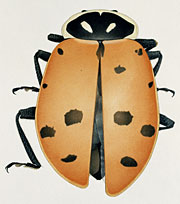
A ladybird beetle found near the Hanford, Wash., nuclear
facilities in 1998. The left wing and outer shell are shorter than those
on the right.
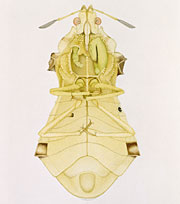
An ambush bug found near the Hanford, Wash., nuclear facilities
in 1998. The left front leg is underdeveloped and crippled.
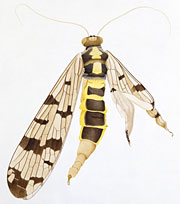
A scorpionfly collected in 1988 near anuclear power plant
in Reuental, Switzerland. Both wings on the rightside are deformed, and
the abdomen is misshapen.
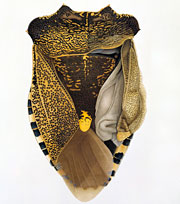
A tree bug collected in 1992 near Zurich, Switzerland. The
right wing is crumpled and has pushed up the thorax.
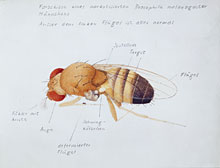
A fourth-generation fruit fly found in RancateTicino, Switzerland, in
1986 after Chernobyl radiation had passed overthe area. Left wing is undeveloped. |
 NUCLEAIRES !
NUCLEAIRES ! NUCLEAIRES !
NUCLEAIRES !